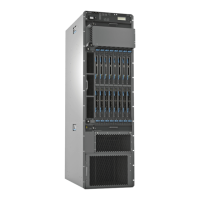To remove a PDU:
1. Switch off the customer site circuit breakers to the PDU being removed.
2. Move the power switch on the PDU to the off (O) position.
3. Make sure that the voltage across the DC power source cable leads is 0 V and that
there is no chance that the cables might become active during the removal process.
Verify that the –48 V 120 A LEDs on the PDU faceplate are off.
4. Attach an electrostatic discharge (ESD) grounding strap to your bare wrist, and connect
the strap to one of the ESD points on the chassis at the front of the chassis.
5. Remove the PSMs in the front of the chassis from the PDU being removed
6. Attach an electrostatic discharge (ESD) grounding strap to your bare wrist, and connect
the strap to one of the ESD points on the chassis at the back of the packet transport
switch.
7. Switch the circuit breakers on the PDU faceplate to the off position (O).
NOTE: After poweringoff a PDU, you must wait atleast 60 seconds before
turning it back on.
8. Loosen the captive screws that secure the input power trays to the PDU.
9. Remove each input power tray from the PDU.
Figure 71: Removing the Input Power Tray
NOTE: It is not necessarytoremove the power cables from the input power
trays when you are replacing the PDU.
10. Loosen the four captive screws attaching the PDU handle to the PDU and chassis.
11. Grasp the handle on the PDU faceplate and pull firmly down toward you. Slide the
PDU halfway out of the chassis (see Figure 72 on page 196).
195Copyright © 2012, Juniper Networks, Inc.
Chapter 15: Replacing Packet Transport Switch Hardware Components

